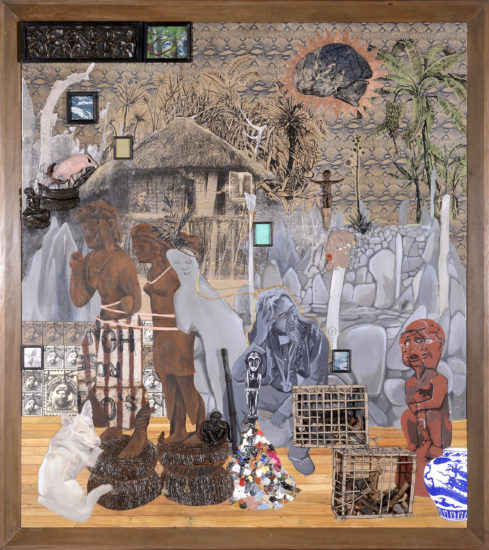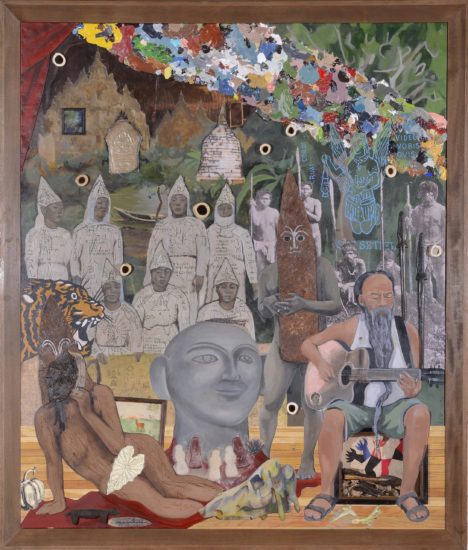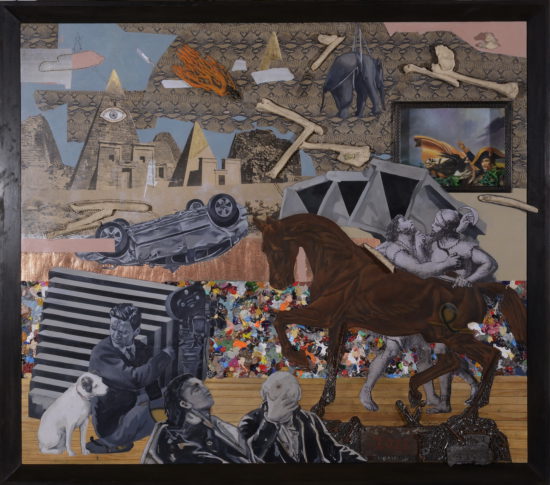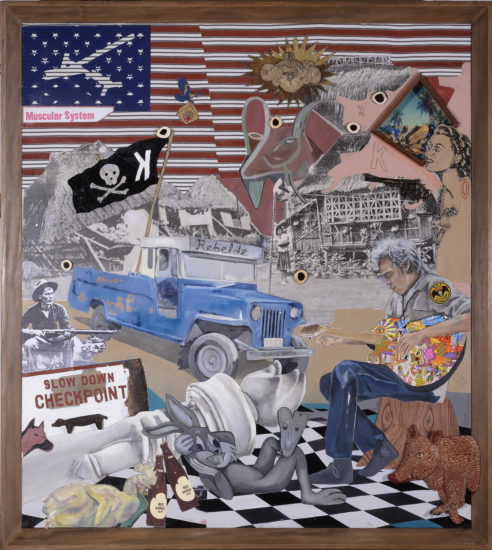FUTURE FICTION
“I’m creating films here… little films, little plots. That’s what’s really happening.”
Kawayan de Guia intuitively addresses how often misconstrued the details in his works are, as though he ritualistically engages in juxtapositions. The figures are not meant to clash. The devils in the details perform synchronously in a garden of earthly delights. That’s what’s really happening. Nothing less is expected of a maximalist.
From afar, the works in Future Fiction maintain his meticulous use of layers of relief, collage, and painting. Known for his installations, objects, and mixed media wall pieces, Kawayan’s recent works were made in a phase where he is at his most “painterly.” But even so, “his approach is still as a sculptor,” says Nona Garcia, Kawayan’s partner who is herself a painter. He’s been at this phase for a few years now, revealing sections of older bodies of works on canvas (like his portraits of mentors and artists). “I feel like he reclaimed something from working on wall pieces that he hasn’t yet exhausted,” continues Nona.
Exhaustion is uncharacteristic of Kawayan who works round the clock. For example, “10 blank canvases hang in his studio, but he still looks for something else to do. One on top of the other. He likes the thrill in that,” says Nona. Even as he was working on two consecutive exhibitions including Future Fiction, he managed to organize a public exhibition to protest the taking over of the Baguio City Market by bureaucrats and mall developers.
The first hour in the morning he keeps exclusively to himself and his notebook. He makes long lists and writes keywords on rebellion or colonization, stuff to be purchased from the hardware store or the lighting store, names of people to meet for projects or ideas, historical details on Cordillera architecture or on the American occupation of Baguio City, until the cacophony is refined into a working plot. A trace of this is found in how he titles his works, a layer of meaning that bookends the process: from words on paper, to the finished canvas, and back to words.
How does Kawayan know when a work is finished?
“There’s always a pause.” Kawayan has learned to be more careful about this period of pause. He admits to how accurate he has to be when filling in the plot holes. When push comes to shove, the canvas is cut or added to. The back of his wall pieces are patchworks of old and new canvas: an homage to the aggregate plasticity of third-world making-do—not of resilience but of survival.
For Future Fiction the patchwork is an intent more than an adjustment due to the COVID-19 crisis. The Philippines is back to square one in its second year coping with the pandemic. During this time, Kawayan has been rediscovering and developing his techniques at the same time using forgotten stretchers and canvases in building his recent exhibitions. Even the objects are from older archives and materials from past projects. “It’s not as if he’s collected stuff for this show. Ten years ago he might have bought something that he’s only using now,” says Nona who’s also been busy working since the beginning of the lockdown in a separate studio just above Kawayan’s.
How does Kawayan start a piece?
“With the type of work I do, you can’t rush it, especially in the beginning.” Kawayan is known for his visual memory. He collects things and keeps a visual catalogue in his head. This mental archive is what he consults in the morning. A habit that permits a confidence in starting a canvas “almost spontaneously but also a bit calculated.”
In Future Fiction, Kawayan began with the word “Rebel.” With each day that he fills pages on his notebook and holes in the plot, that theme has changed drastically. Remnants of it however remain in the painted bullet holes in Fabricated Sanctum or the jeep called Rebelde in Rebel Music: Immortalizing the Legacy of Pepe Smith. The “little films” emerge as monuments and heroes from a nation in the visible horizon. But Future Fiction also appropriates this horizon to imagine what comes after.
Rocky Cajigan






